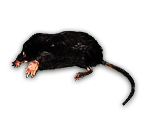EASTERN MOLE
(Scalopus aqauticus)
General Characteristics:
- Most common species in North America
- The eyes and ears are small and concealed by fur
- The fur is gray to silver in colour with a “velvet like” appearance
-
Will grow to Approx 5-7 inches including tail
-
They are insect feeders, mostly earthworms, beetle grubs, ants, arthropods and animals in soil
- Well equipped for life underground, large outward pointing claws and feet for digging
- The fur can point forward or backwards to aid with movement
- Not rodents as they are a part of a group of mammals from a division of the order Insectivora called Soricomorpha, closely related to shrews
Reproduction:
- Breeding occurs once a year and begins late March to early April
- Gestation is 4 weeks to 45 days
- 2-5 young per litter
- independent in 1 month and sexually mature in 1 year
Signs of Infestation:
- The tunnels created underground can often damage lawn root systems, however the majority of lawn damage is more attributable to the other insect and mammal species that will utilize tunnels
- The mole is attracted to white grubs( Beetle larvae ),therefore if beetle larvae activity is reduced, the lawn is then less conducive to moles
Control Techniques:
- Several methods available for control, lethal trapping is the most reliable method and if set effectively, often provides quick results
- Discouraging moles with barriers can also be effective (i.e. Stones, compacted soil, clay, hardware cloth, fencing etc…)
- Live Trapping can be useful by burying a coffee can below tunnel line and covering. Device must be checked daily.
- Physical control can also include flushing with water; spring flooding may occur naturally. Flooding can also be created by the home owner, may require 10-20 minutes to flush adult which should be dealt with accordingly.
Please click here to contact a Focus Pest Control professional to inquire about further treatments for this pest species.
References:
Benett, Gary W., et.al.. Truman’s Scientific Guide to Pest Control Operations. Duluth: Advanstar Communications, 1988.
Pp. 359-361.
Gorog, A. 1999. "Scalopus aquaticus" (On-line), Animal Diversity Web. Accessed May 15, 2009 at
http://animaldiversity.ummz.umich.edu/site/accounts/information/Scalopus_aquaticus.html.
STAR NOSED MOLE
(Condylura cristata)
General Characteristics:
- Native to eastern North America
- The eyes and ears are small and concealed by fur
- The fur is coarse and light to dark brown in colour
- Nose is hairless and is circled by a unique 'star' of 22 pink, fleshy appendages
- Will grow to Approx 6-8 inches and weight 1 -2 ½ ounces
- Semi-aquatic
- Well equipped for life underground, large outward pointing claws and feet for digging
- Invertebrate feeder that primarily feeds on aquatics including worms, leeches, caddisflies, midges, dragonflies and damselflies, crane flies, horse flies, predacious diving beetles and stoneflies
- Will occasionally feed on terrestrial insects, aquatic crustaceans, molluscs and small fish
- Excellent hearing, but eyes only suited to differentiate between light and dark
Reproduction:
- Breeding occurs once (sometimes twice) a year and begins late March to early April
- Monogamous during breeding season
- 45 day gestation period
- 2-7 young per litter
- independent in 30 days month and sexually mature in 10 months
Signs of Infestation:
- Shallow surface tunnels created underground can often damage lawn root systems, however the majority of lawn damage is more attributable to the other insect and mammal species that will utilize tunnels
- Loose soil from tunnelling pushed to surface to form mole hills
Control Techniques:
- Several methods available for control, lethal trapping is the most reliable method and if set effectively, often provides quick results
- Discouraging moles with barriers can also be effective (i.e. Stones, compacted soil, clay, hardware cloth, fencing etc…)
- Live Trapping can be useful by burying a coffee can below tunnel line and covering. Device must be checked daily.
References:
Benett, Gary W., et.al.. Truman’s Scientific Guide to Pest Control Operations. Duluth: Advanstar Communications, 1988.
Pp. 359-361.
Zera, S. and P. Myers. 2004. "Condylura cristata" (On-line), Animal Diversity Web. Accessed May 15, 2009 at http://animaldiversity.ummz.umich.edu/site/accounts/information/Condylura_cristata.html.
Disclaimer:
The Focus Pest Control ‘Pest Library’ is an educational resource written largely to educate the general public about common pests in Ontario. The Focus ‘Pest Library’ does not include all species in Ontario, nor does it include the most recent scientific data about species we describe. Though we edit our accounts for accuracy, we cannot guarantee all information in those accounts. While Focus Pest Control staff and contributors provide references to books and websites that we believe are reputable, we cannot necessarily endorse the contents of references beyond our control.
(Back to top)
|


